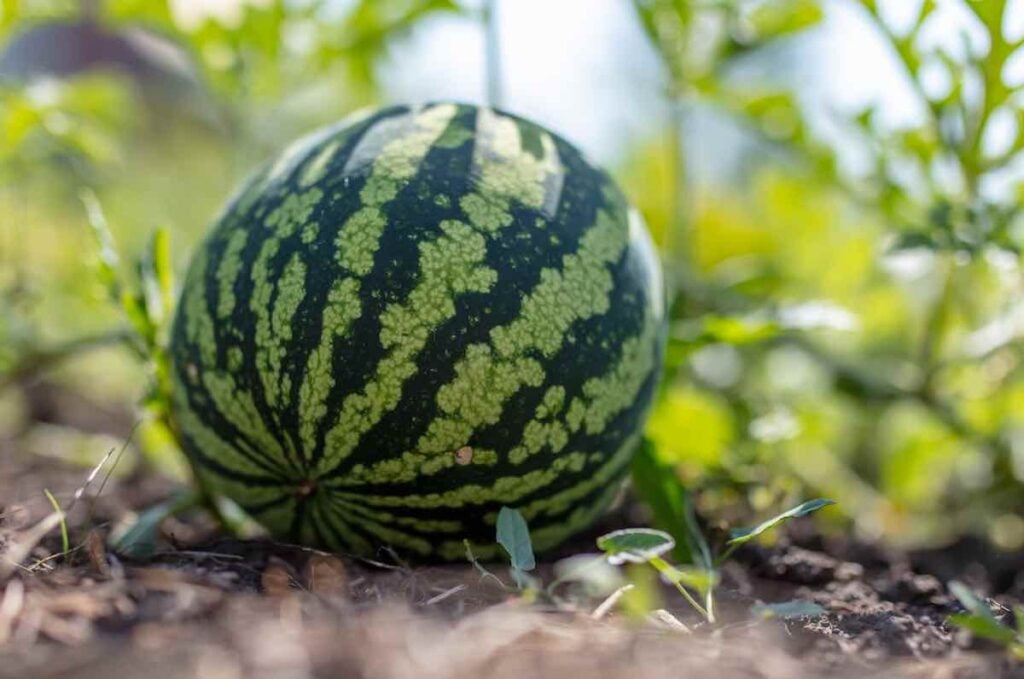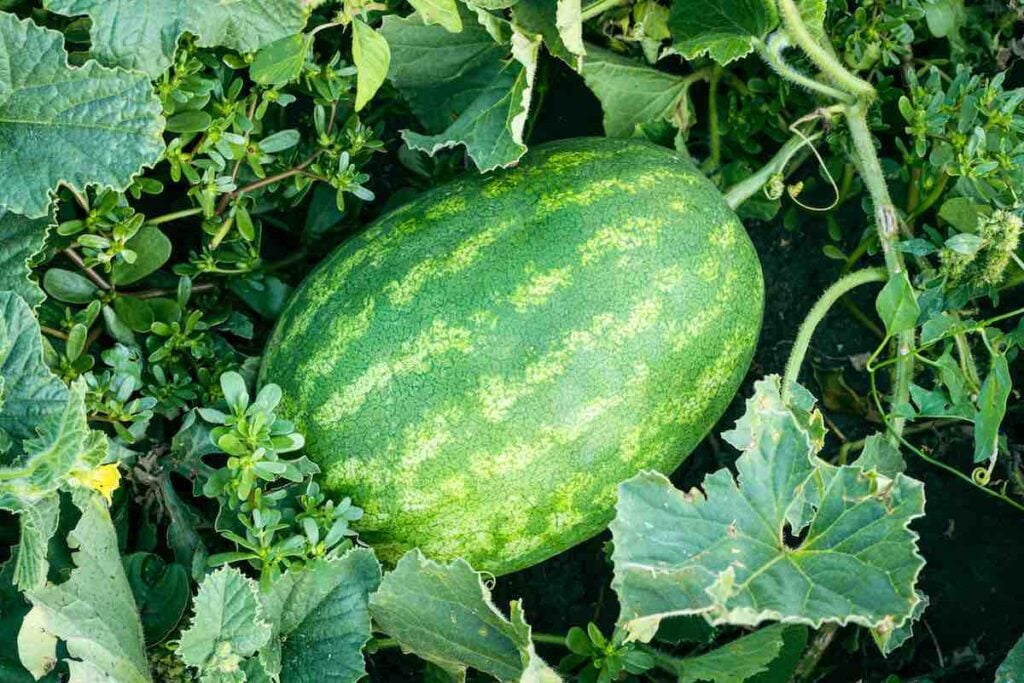As the watermelon growing season continues and your melons grow larger and larger on their vines, the question is likely hovering in the back of your mind—how do I know when to harvest my watermelons? And what is the best method for how to harvest watermelon?

I’m here to help! Read on to learn the best indications of watermelon ripeness and how to harvest watermelon in such a way that your plant continues to thrive!
How to Determine A Watermelon is Ready to Be Harvested

There are several key factors at play that can help you know not just how to harvest watermelon, but when is the best time to do so for optimal enjoyment of this delicious fruit. Keeping these factors in mind will help ensure you harvest your watermelon when it is at its peak condition.
Judging by the Field Spot
When it comes to learning how to harvest watermelon, becoming familiar with what a field spot is and what it tells us about the ripeness of the watermelon is a big deal!
Though it has historically been thought by some that the presence of a creamy yellowish or browning patch on a watermelon rind stands as an indicator that it is overripe, past maturity, or possibly even on its way to rotting, this is actually not the case!
This pale patch, often called a “field spot”, is located on what could be considered the underside of a watermelon and is indicative of where the watermelon rested against the ground (within a field, hence “field spot”) as it ripened; this patch will not have turned the same shade or shades of green during the ripening process due to lack of exposure to the sun. This spot is a great indicator not just of the ripeness of our own homegrown melons, but it is also a great method to determine the ripeness of whole watermelons purchased from the grocery store as well!
Go ahead and search your watermelons for this patch of ground-facing pallor. If the field spot is still white, or hardly present at all, this tells us that the watermelon is not yet ripe; go ahead and flip the watermelon back over to place the field spot back in contact with the soil, as this will prevent that sensitive area from scalding on contact with the sun. Continue to check that same patch for yellowing over time to indicate ripeness.
However, if the field spot is already a buttery yellow hue, that indicates to us that the watermelon is ripe; the larger the field spot grows and the yellower it becomes, even turning slightly brownish, the riper it is. Once we have determined the status of the field spot, the most prominent indicator and first step of how to harvest watermelon is complete!
The Color and Texture of the Rind
Another important factor in knowing when and how to harvest watermelon is to determine if the color and texture of the rind indicate ripeness.
All watermelons will undergo at least some color change as they mature and ripen, which is what makes the field spot such a helpful clue as to the readiness of your melons. However, there are other indicating factors in the rind that can help you determine if it is time to truly get into the details of how to harvest watermelon.
Take a look at the rind of your watermelon once it has turned to a desired green shade (note that this factor will be in play regardless of if you are growing a striped or unstriped variety of watermelon, though darkening stripes will also help determine ripeness in such varieties). Is the rind glossy and smooth? If so, then it is likely not fully ripe yet. As watermelons mature and ripen, the rind will typically change from glossy to dull and become rougher and more textured, so you can tell by touch if it has a ways to go.
If you find the rind to be more of a matte hue and rough to the touch, but are still unsure if it is ripe, you can try piercing the rind with your fingernail. An unripe watermelon will be easy to pierce through, whereas a rind that is tough and resistant, as well as dull, rough, and green with a field spot present, all together serve as an indication that it is time to move to the next step in how to harvest watermelon!
Plant Indicators of Ripeness
Last bust not least, there are some factors within the watermelon plant itself that will help you to determine if you are ready to continue in the process of how to harvest watermelon. Observe the corkscrewed tendril that lies on the main vine of your watermelon plant, nearest to the fruit itself; when this tendril starts to brown and stiffen, that is usually an indication that the ripening process has reached its end. Another sign to watch out for is the yellowing of the leaves closest to the watermelon; as these parts of the plant serve their purpose and become no longer are necessary, the plant will cease to feed them, leading to yellowing, crisping, and wilting overall.
How to Harvest Watermelon From a Garden

Once you have confidently determined that the time is right to harvest your watermelons, now comes the fun part—actually learning how to harvest watermelon properly!
When it comes to a standard garden, the trick on how to harvest watermelon lies in using your garden tools and knowing what you want from your watermelon plant. It is important not to twist or yank your ripe watermelons from the vine, especially if you intend to continue harvesting from the same plant, as this rough handling can damage your watermelon plant and have a negative impact on future crops.
Instead, you will want to take your garden shears or sharpened plant scissors and cut the watermelon from the vine, while leaving several inches of stem attached to the fruit. Make sure not to use any tools with dull edges, as this can cause damage to the vine as well.
And just like that, you have mastered how to harvest watermelon from your garden! Be sure to handle the fruit with care to avoid bruising, and repeat these steps with each melon to determine the ripeness and to properly harvest these future melons in your crop.
How to Harvest Watermelon From A Container

If you have a bush, dwarf, or mini cultivar of watermelon growing in a container indoors, you may struggle with figuring out the best time and means of how to harvest watermelon; luckily, though you likely will not have a field spot to help as a determining factor, you should be able to determine by the color and texture of the rind and the indications from the plant itself when your watermelon is ready to harvest.
Once you are certain your indoor watermelon is ready to be harvested, simply follow the same steps as the ones for how to harvest watermelon from a garden: use a sharp-edged tool to remove the watermelon with a few inches of stem left intact. Though an indoor watermelon plant will likely only produce a single fruit, it is still considered best practice to trim off the fruit rather than twisting and pulling it from the vine.
Wrapping Up How to Harvest Watermelon
Feeling confident about how to harvest watermelon now? There is so much more to learn about this delicious fruit, even once you’ve harvested your crop!
Want to learn more about this iconic summer fruit? Then visit our watermelon plants page to learn more about watermelon planting, growing, cooking, and more!
- About the Author
- Latest Posts
Renee Dugan is a lifelong writer, professional editor, and lover of all things nature, gardening and the big outdoors.
A Midwest girl who’s been in the garden since she could first hold a hand trowel, Renee’s love of growing things has bloomed into a passion for healthy living, holistic lifestyle, and knowing where our food comes from.
Now a mother and maturing gardener herself, Renee is passionate about channeling everything she knows and continues to learn about gardening into lessons for her son and others. Her excitement for sharing this knowledge is only superseded by her excitement about being able to finally grow her own citrus plants in pots.
Renee can be reached at renee.s.dugan@gmail.com

